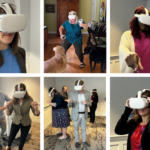How to make your next meeting more engaging – for everyone
September 24, 2021

If we’ve learned anything from the past year and a half, it’s that virtual meetings are here to stay. Yes, much like the stretchy pants I own in every color – these puppies aren’t going anywhere. And with companies like Target, Citigroup and Ford moving to a hybrid model, it’s likely your company is rolling out similar plans of its own. Or perhaps your company has always managed a dispersed workforce with teams in labs, research facilities or manufacturing sites. Either way, internal communicators are tasked with organizing virtual meetings of every scale and for many reasons.
Unlike my fave stretchy pants, virtual meetings tools are not one-size-fits-all. Each meeting and its participants are unique. And the needs of the meeting should be tailored to the purpose. You wouldn’t treat a 6-hour car ride with the kids the same as your morning solo coffee run, right? Same thing goes for a brainstorm session vs a global Town Hall.
Let’s address the three most common types of internal meetings, and review tips and best practices for making each of them engaging – for all participants.
Brainstorm sessions
One could argue that the virtual or hybrid environment has most impacted our ability to run productive and engaging brainstorm sessions. Because we’re not in the same room, it can be difficult to collaborate, build on discussions or whiteboard ideas that flow. Enter Miro, an online collaborative whiteboard platform that promises to bring teams together anytime and anywhere. We love Miro for a few reasons:
- Getting started is super easy, thanks to hundreds of available templates
- Adding your team is even easier – just send a quick email invite through your dashboard
- Collaborating on a board is incredibly fun and interactive
Miro allows you to do more than brainstorm as a team. Within each board, you can chat (message or video), comment on changes/ideas and tag team members. Miro integrates with nearly every collaboration program you’re using now – Teams, Webex, Zoom, oh my! You can also create boards for concept mapping, strategy planning, SWOT analyses and project management and export them into separate files.
Town Hall or All-Hands meetings
By now we’ve all supported or attended multiple virtual Town Hall meetings (some more engaging than others!). Whether you have a handful of speakers, one presenter or a panel discussion, there are a few ways to ensure your Town Hall is engaging for everyone:
- Always ask employees to submit questions ahead of time by including a “Submit a question” link in the invite. Make sure these questions get answered during the meeting, so your employees know they are being heard.
- Allow your speaker to be on-camera during the welcome and closing, long periods of presenting and the Q&A. Seeing the host’s face helps attendees feel like they’re talking to an actual person – and makes them feel connected to the subject matter – aka your company!
- Infuse interactive elements like polling, word clouds or quizzes using Slido, a web-based interaction app that integrates with all the major players in meeting platforms. Real-time feedback is a great way to make everyone feel connected and engaged.
Field employee meetings or webinars
I recently attended a six-hour webinar that had more than 500 attendees. Going into it, I worried I would spend six hours simply listening to a speaker and feel disconnected to the meeting. I was one of 500 people and it’s easy to feel like you’re just a name in the participants list! But I was pleasantly surprised by the way the hosts ran the production. At the beginning of the webinar, the moderator encouraged the audience to use the built-in reactions in the meeting platform, instead of sharing thoughts through the chat. This allowed us to quietly react, yet still participate in the conversation. So many of us clapped or “celebrated” for the innovative ideas presented and it made us feel like we were in the same room.
We were also encouraged to use the Q&A function in the meeting platform while the presenters spoke or shared. The moderator collected the questions throughout the section, and the host addressed them before we moved onto the next topic. Asking questions in real-time made the webinar feel more like a conversation.
The togetherness carried on even after the meeting ended. About an hour after the webinar ended, we received a replay link, survey and the toolkit presented during the webinar. I’m sure those who couldn’t attend all six hours were thankful to have the replay available to watch at their convenience, and the survey helped my brain jog through the program, highlighting the most memorable discussions.
But wait, there’s more!
If you use Microsoft Teams for meetings, stop taking meeting notes. Teams does it for you! Make sure you record your meeting and once the recording is available, open the file in Microsoft Stream. You can autogenerate a caption file that serves as a transcript of your meeting.
If Webex is your go-to meeting service, be sure to utilize the in-app polling feature. It’s a true hidden gem! You must have the panel for polling enabled but once it’s added to your meeting dashboard, you’ll be ready to capture your participants’ reactions in real-time.
For all my fellow Zoom meeting fans, make sure you change your name and pronouns in your profile. You’ll agree it’s much nicer to see “Michelle Petrillo” vs “mpetril” underneath my name each time I sign on. Adding your pronouns to your name is a great way to make the platform more inclusive for transgender, gender-nonconforming and gender nonbinary people, and ensures you don’t make assumptions on people’s pronouns based on their appearance.
Do you have tips or tricks you’d like to share? Send them in the comments!






